ORDINARY BEAUTY, MODEST MIRACLES:
Max’s Travel Journal, summer ’08
St. Louis, then to New Orleans via Amtrak, then on to LA.
CHAPTER TWO: The Spirit of St. Louis, Conclusion
In Search of Amtrak: a Story
 |
St. Louis’ palatial Union Station, opened in 1894, was once the largest train station in the world! It's fronted by the “Milles Fountain”, representing the nearby confluence of the
Mississippi and Missouri Rivers.
Milles’ sexual playfulness with his figures was too much for the city fathers, who changed its name from “Wedding of the Waters” to “Meeting of the Waters”. |
I'm scheduled to leave by rail for New Orleans at 11 pm tomorrow night. I'm supposed to pick up my ticket, which I booked via the Internet a month or so ago, prior to departure. I also want to ask the Amtrak agent a couple of questions before departure. Actually, I leave St. Louis on a bus, I learned when booking. It will take me to Carbondale, Illinois, about a hundred miles away. There I'll rendezvous with the oft-sung City of New Orleans train, making its way south from Chicago.
I want to find out two things: 1) Will it be possible to upgrade to some kind of sleeper berth, should I feel on the verge of madness by my second night in a coach seat during the 48-hour journey from New Orleans to Los Angeles? And 2) Since I’ve heard the Sunset Limited train between those cities often arrives late (and I have business in Los Angeles on Sunday morning)—how late is it, most of the time?
First, I had to answer another question. Where the hell is the station?
I knew, vaguely, that it's remained somewhere in the vicinity of Union Station, the grand old depot of the heyday of St. Louis’ days as a great rail center, which today houses a vast mall as well as the local Hyatt Regency Hotel. So I pointed my car in that direction, and parked at a meter across Market Street, directly in front of Milles Fountain.
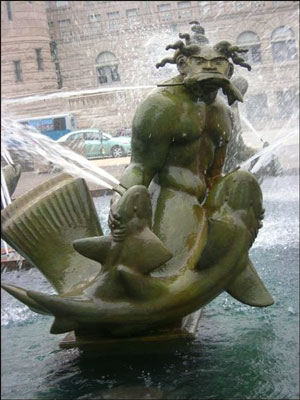
Fishy gargoyle: a wonderful detail from the fountain.
I crossed Market Street and made my way into the Hyatt Regency, which has preserved the Grand Hall of the station, created in what can only be called the Gilded Age:
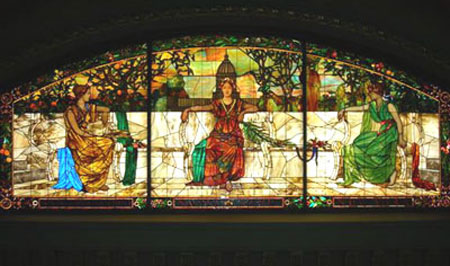 |
| “Allegorical Window" in the Grand Hall, created in the 1890’s by the Tiffany Company. The three ladies are said to represent the three major American railroad depots of the time: New York, St. Louis, and San Francisco. |
Once through the hotel and on into the mall area, where parenthetically I saw my first display of Barack Obama t-shirts,

I looked without success for a sign pointing the way to Amtrak. I thought, “Well, this old station is so huge—maybe they’ve left one single track functional, somewhere. ” After some time, I decided to ask the Security man who was sitting in a glassed-in booth with the surveillance camera monitors. “Go all the way through and out the door,” he said. I started walking. Maybe the “last train track” and some kind of mini-terminal were outside there, although I’d never noticed them before.
Pushing the door open and walking out into the warm, humid day, I saw only several restaurants, one of them pleasantly situated on a small artificial lake plashed by a nice fountain, and beyond that several refurbished office buildings to which I used to make deliveries when I was a courier. It was lunch time, and I noticed a little group of people with badges that said AMERIN. That's the name of the St Louis area's Electric Company, whose main office was in this neighborhood. There was a good chance these folks would know.
“It’s over that way,” one of them answered my query, hooking a finger. “I’m not sure exactly where. Go down to the street and turn left, go two or three blocks. And then ask somebody else!”
The elusiveness of the Amtrak Station was very strange. So they had removed it altogether from St. Louis’ historic railroad building! Well, this was an adventure, and that was what I’d signed up for. I walked out to the sidewalk, crossed the street, turned east and traversed the cross-street, and kept going. Down the grassy hill to my right, I could see tracks and a platform for the Metrolink, the new, local mass transit train. But still no Amtrak.
A short block ahead, a group of four blue-uniformed men and women were approaching. I thought they might be police cadets. Cadets would certainly be able to give me directions. As they got closer, I saw that their uniforms said U.S. Coast Guard. Well, they worked downtown, and were likely to be informed, aware people.
“Yes,” said one of them in a friendly voice, pointing into the distance. “You cross that little bridge up there, to the right. Amtrak is that colored building over beyond the bridge.”
“Thank you so much!” I said. Though I couldn’t really see a colored building, I still trusted his directions. Soon I turned right to cross the little bridge that went over the Metrolink tracks. Sure enough, an ancient, bent-up green sign did say AMTRAK, with an arrow pointing in the direction I was heading.
A couple more blocks and I was in an area where it was hard to make out what was what! There was a dirt road, a grassy place under a raised highway entrance and all sorts of parked cars, some looking like junkers. Then, in the distance, I finally did spy a rather pleasant-looking building with square windows of blue, red, and yellow. Approaching it, I saw—Hurray!—the word STATION in big letters, and then, once I was past a metal girder blocking my vision, the word GATEWAY.
With hurried steps I went under the arch of an open door to find four executive-looking people standing together, talking. I looked past them, however, and saw the building was full of clean hallways that were totally empty. I voiced my question:
“Is this station open?”
“Not yet,” smiled a woman in the group.
“Where’s the old station, then?”
“You have to go back that way,” she said, pointing into the maze of parked and junked cars, grass, dirt road, black metal fences, and highway abutments. I squinted and saw nothing. Then, amid all the clutter, I spied a little brick, pillbox building, with a large, red bus in front of it.
“Is that it?”
“Uh-huh,” the lady smiled.
“It’s not very well marked!” I said in as friendly a manner as I could, as I walked away, thinking of others who would be coming this way, and of the single sign whose trail then stopped cold. The lady mumbled something I couldn't hear, and I'll never know whether her reply was an appreciation of my feedback or a justification of how things were.
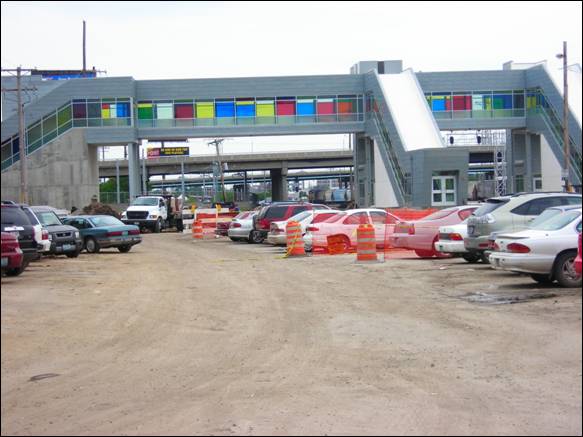
Part of the new Amtrak station, completed but not yet opened, as of June, 2008
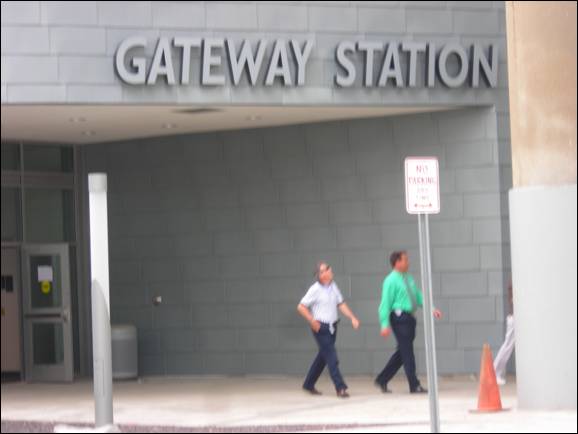
Two of the executives leaving the new station after their conclave.
Walking out of the station-to-be, I backtracked for a block or so. Then I started making my way over to the pillbox. There was a dirt road through a gap in the fence, I saw. As I walked along it a little later, half expecting to see chickens running around at my feet, the red bus started up. Stirring up huge clouds of dust, it pulled out, turned around, and started coming my way.
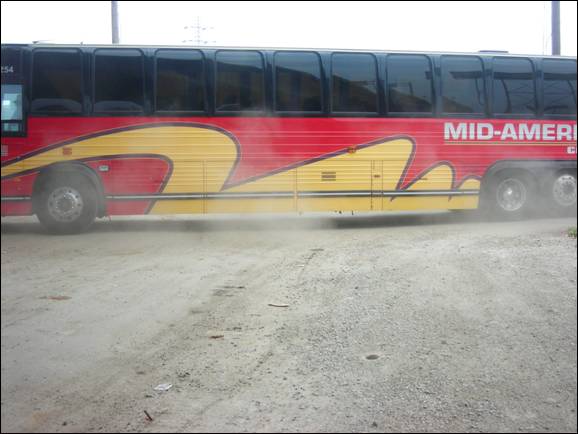
The bus swirling up dust-dervishes on the “country dirt road” in
the middle of St. Louis, in front of the current Amtrak station.
It drove past me, and I made my way on into the station.
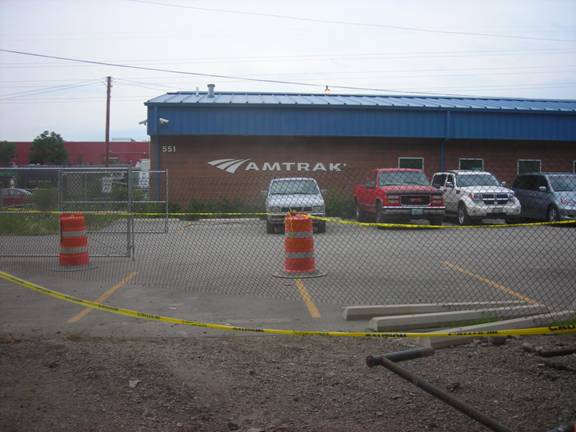
The station—known as “Amshak”— that has served St.
Louis rail passengers since 1978. It is soon to be retired.
Once inside, a little baffled that our nation’s great railway traditions has come to this, I got my ticket print-outs and asked the agent my questions. I may be able to upgrade, she said. I'll have to ask on the train. All the sleeping compartments are booked, but sometimes people with reservations don't show up.
As for the Sunset Limited arrival times, the only record still on their computers is the most recent train. That one arrived 3 hours late. The reason for this, I learned, is that Amtrak does not own all the tracks, and sometimes they have to wait for other trains.
Well, I'm resigned. The station's not much, and I had to do quite a bit of work to get the agent to answer my questions. But as long as the trains themselves are ok, I’ll be happy. They, of course, remain an unknown, but only until tomorrow night when my brother drops me off here.
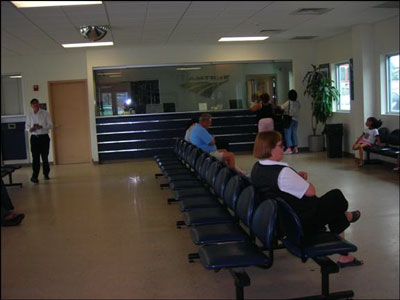
on to CHAPTER THREE:
back to first part of Chapter Two
back to Chapter One
back to Contents
back to Title








